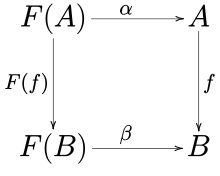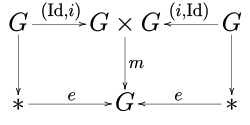F-algebra

In mathematics, specifically in category theory, F-algebras generalize algebraic structure. Rewriting the algebraic laws in terms of morphisms eliminates all references to quantified elements from the axioms, and these algebraic laws may then be glued together in terms of a single functor F, the signature.
F-algebras can also be used to represent data structures used in programming, such as lists and trees.
The main related concepts are initial F-algebras which may serve to encapsulate the induction principle, and the dual construction F-coalgebras.
Definition
If C is a category, and F: C → C is an endofunctor of C, then an F-algebra is a tuple (A, α), where A is an object of C and α is a C-morphism F(A) → A. The object A is called carrier of the algebra. When it is permissible from context, algebras are often referred to by their carrier only instead of the tuple.
A homomorphism from an F-algebra (A, α) to an F-algebra (B, β) is a C-morphism f: A→ B such that f o α = β o F(f), according to the following diagram:

Equipped with these morphisms, F-algebras constitute a category.
The dual construction are F-coalgebras, which are objects A* together with a morphism α* : A* → F(A*).
Examples
Groups
Classically, a group is a set G with a binary operation m : G × G → G, satisfying three axioms:
- associativity
- ∀ x∈G, ∀ y∈G, ∀ z∈G, m(m(x, y), z) = m(x, m(y, z)).
- identity element
- ∀ x∈G, ∃ 1∈G, m(1, x) = m(x, 1) = x.
- inverse element
- ∀ x∈G, ∃ 1∈G, ∃ x−1∈G, m(x−1, x) = m(x, x−1) = 1.
Note that the axiom of closure is included in the symbolic definition of m.
To treat this in a categorical framework, we first define the identity and inverse as functions (morphisms of set in a category) e and i respectively. Let C be an arbitrary category with finite products and a terminal object *. The group G is an object in C. The identity function e sends each element in * to 1, the identity element in the group G. The inverse function i sends each element x in G to its inverse x−1, satisfying m(x−1, x) = m(x, x−1) = 1. Then a group G can be defined as a 4-tuple (G, m, e, i), which describes a monoid category with only one object G. Each morphism f in this monoid category has an inverse f−1 that satisfies f−1 o f = f o f−1 = Id.[1]
It is then possible to rewrite the axioms in terms of functions (note how the existential quantifiers disappear):
- ∀ x∈G, ∀ y∈G, ∀ z∈G, m(m(x, y), z) = m(x, m(y, z)).
- ∀ x∈G, m(e(*), x) = m(x, e(*)) = x.
- ∀ x∈G, m(i(x), x) = m(x, i(x)) = e(*).
Then remove references to the elements of G (which will also remove universal quantifiers):
- m∘(m, Id) = m∘(Id, m).
- m∘(e, Id) = m∘(Id, e) = Id.
- m∘(i, Id) = m∘(Id, i) = e.
Which is the same as claiming commutativity for the following diagrams:[2]
 ,
,  ,
,  .
.
Now use the coproduct (the disjoint union of sets) to glue the three morphisms in one: α = e + i + m according to
This defines a group as a F-algebra where F is the functor F(G) = 1 + G + G × G.
Note 1: The above construction is used to define group objects over an arbitrary category with finite products and a terminal object *. When the category admits finite coproducts, the group objects are F-algebra. For example, finite groups are F-algebras in the category of finite sets and Lie groups are F-algebras in the category of smooth manifolds with smooth maps.
Algebraic structures
Going one step ahead of universal algebra, most algebraic structures are F-algebras. For example, abelian groups are F-algebras for the same functor F(G) = 1 + G + GxG as for groups with an additional axiom for commutativity: m∘t = m, where t(x,y) = (y,x) is the transpose on GxG.
Monoids, which generalize groups in that a monoid element does not need to have an inverse, are F-algebras of signature F(M) = 1 + MxM. In the same vein, semigroups are F-algebras of signature F(S) = SxS
Rings, domains and fields are also F-algebras with a signature involving two laws +,•:RxR → R, an additive identity 0:1 → R, a multiplicative identity 1:1 → R, and an additive inverse for each element -:R → R. As all these functions share the same codomain R they can be glued into a single signature function 1 + 1 + R + RxR + RxR → R, with axioms to express associativity, distributivity,... This makes rings F-algebras on the category of sets with signature 1 + 1 + R + RxR + RxR.
Alternatively, we can look at the functor F(R) = 1 + RxR in the category of groups. In that context, the multiplication is a homomorphism, meaning m(x+y, z) = m(x,z)+m(y,z) and m(x,y+z) = m(x,y)+m(x,z), which are precisely the distributivity conditions. Therefore, rings are F-algebras of signature 1 + RxR over the category of groups which satisfies two axioms (associativity and inverse for the multiplication).
When we come to vector spaces and modules, the signature functor includes a scalar multiplication kxE → E, and the signature F(E) = 1 + E + kxE is parametrized by k over the category of fields, or rings.
Algebras can be viewed as F-algebras of signature 1 + 1 + A + AxA + AxA + kxE over the category of sets, of signature 1 + AxA over the category of modules (a module with an internal multiplication), and of signature kxE over the category of rings (a ring with a scalar multiplication).
Lattice
Not all mathematical structures are F-algebras. For example, a poset P may be defined in categorical terms with a morphism s:P → Ω, on a subobject classifier (Ω = {0,1} in the category of set and s(x,y)=1 precisely when x≤y). The axioms restricting the morphism s to define a poset can be rewriten in terms of morphisms. However, as the codomain of s is Ω and not P, it is not an F-algebra.
However, lattices in which every two elements have a supremum and an infimum, and in particular total orders in which every two elements are comparable, are F-algebras. This is because they can equivalently be defined in terms of the algebraic operations: x∨y = inf(x,y) and x∧y = sup(x,y), subject to certain axioms (commutativity, associativity, absorption and idempotency). Thus they are F-algebras of signature PxP + PxP. It is often said that lattice theory draws on both order theory and universal algebra.
Recurrence
Consider the functor that sends a set to . Here, Set denotes the category of sets, denotes the usual coproduct given by disjoint union, and 1 is a terminal object (i.e. any singleton set). Then the set of natural numbers together with the function , which is the coproduct of the functions (whose image is 0) and (which sends an integer n to n+1), is an -algebra.
Initial F-algebra
If the category of F-algebras for a given endofunctor F has an initial object, it is called an initial algebra. The algebra in the above example is an initial algebra. Various finite data structures used in programming, such as lists and trees, can be obtained as initial algebras of specific endofunctors.
Types defined by using least fixed point construct with functor F can be regarded as an initial F-algebra, provided that parametricity holds for the type.[3]
See also Universal algebra.
Terminal F-coalgebra
In a dual way, similar relationship exists between notions of greatest fixed point and terminal F-coalgebra, these can be used for allowing potentially infinite objects while maintaining strong normalization property.[3] In the strongly normalizing Charity programming language (i.e. each program terminates in it), coinductive data types can be used achieving surprising results, e.g. defining lookup constructs to implement such “strong” functions like the Ackermann function.[4]
See also
Notes
- ↑ Section I.2, III.6 in Mac Lane, Saunders (1988). Categories for the working mathematician (4th corr. print. ed.). New York: Springer-Verlag. ISBN 0-387-90035-7.
- ↑ The vertical arrows without labels in the third diagram must be unique since * is terminal.
- 1 2 Philip Wadler: Recursive types for free! University of Glasgow, June 1990. Draft.
- ↑ Robin Cockett: Charitable Thoughts (ps and ps.gz)
Further reading
- Pierce, Benjamin C. "F-Algebras". Basic Category Theory for Computer Scientists. ISBN 0-262-66071-7.
External links
- Categorical programming with inductive and coinductive types by Varmo Vene
- Philip Wadler: Recursive types for free! University of Glasgow, June 1990. Draft.
- Algebra and coalgebra from CLiki
- B. Jacobs, J.Rutten: A Tutorial on (Co) Algebras and (Co) Induction. Bulletin of the European Association for Theoretical Computer Science, vol. 62, 1997
- Understanding F-Algebras by Bartosz Milewski